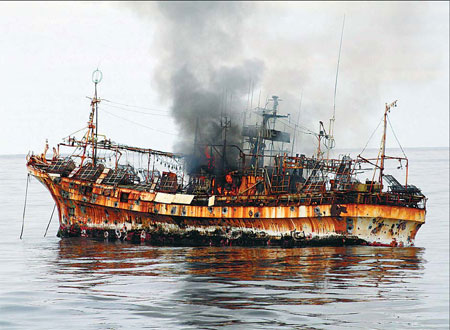Cannon fire sinks Japanese ghost ship
Updated: 2012-04-07 07:44
By Associated Press in the Gulf of Alaska (China Daily)
|
||||||||
|
The Japanese fishing vessel, Ryou-Un Maru, shows significant signs of damage after US Coast Guard cutter Anancapa fired explosive ammunition into it, about 290 kilometers west of the Southeast Alaskan coast on Thursday. US Coast Guard via Reuters |
The long, lonely voyage of the Japanese ghost ship is over.
A US Coast Guard cutter unleashed cannon fire on the abandoned 50-meter Ryou-Un Maru on Thursday, ending a journey that began when last year's tsunami dislodged it and set it adrift across the Pacific Ocean.
It sank into waters more than 305 meters deep in the Gulf of Alaska, more than 240 kilometers from land.
The crew pummeled the ghost ship with high explosive ammunition, and the Ryou-Un Maru soon burst into flames, and began to take on water and list, officials said.
A huge column of smoke could be seen over the gulf as a coast guard C-130 cargo plane, sent to observe the sinking, dropped a buoy to monitor for any possible pollution from the sunken ship.
The coast guard warned mariners to stay away, and aviation authorities did the same for pilots.
In about four hours, the ship vanished into the water, said Chief Petty Officer Kip Wadlow in Juneau.
Officials decided to sink the ship rather than risk the chance of it running aground or endangering other vessels in the busy shipping lanes between North America and Asia.
The ship had no lights or communications system, and its tank was able to carry more than 7,570 liters of diesel fuel. Officials, however, didn't know how much fuel, if any, was aboard.
"It's less risky than it would be running into shore or running into (maritime) traffic," coast guard spokesman Paul Webb said.
The US National Oceanic and Atmospheric Administration and the Environmental Protection Agency studied the problem and decided it is safer to sink the ship and let the fuel evaporate in the open water.
The ship was at Hokkaido, Japan, and destined for scrapping when a magnitude-9.0 earthquake that struck the country in March 2011 triggered a tsunami.
The waves dislodged the vessel and set it adrift. In total, about 5 million tons of debris was swept out to sea.
The boat did not have any cargo aboard, Webb said. He said he didn't know who owned the Ryou-Un Maru, which had been traveling about 1 mph in recent days.
As the coast guard was readying to fire on the vessel, a Canadian fishing vessel, the 19-meter Bernice C, claimed salvage rights over the ghost ship in international waters.
Plans to sink it were halted so the Canadian crew could have a chance to take the stricken ship. A Canadian official with knowledge of the situation told The Associated Press that the Bernice C was unable to tow it.
That delay, in part, prompted the cargo plane to return to Kodiak, Alaska, before the ship sank because the plane burned up fuel while circling the area monitoring the situation.
The Canadian boat left, and once it was about 10 kilometers from the Japanese vessel, the Coast Guard began to fire, first with 25 mm shells, then a few hours later with ammunition twice that size.
In the year since the tsunami, the debris from Japan has washed up on shores across the Pacific.
In January, a half dozen large buoys suspected to be from Japanese oyster farms appeared at the top of Alaska's panhandle and may be among the first debris from the tsunami.
State health and environmental officials have said there's little need to be worried that debris landing on Alaska shores will be contaminated by radiation.
The earthquake triggered the world's worst nuclear crisis since the Chernobyl accident in 1986.
State officials have been working with federal counterparts to gauge the danger of debris including material affected by a damaged nuclear power plant, to see if Alaska residents, seafood or wild game could be affected.

 Relief reaches isolated village
Relief reaches isolated village
 Rainfall poses new threats to quake-hit region
Rainfall poses new threats to quake-hit region
 Funerals begin for Boston bombing victims
Funerals begin for Boston bombing victims
 Quake takeaway from China's Air Force
Quake takeaway from China's Air Force
 Obama celebrates young inventors at science fair
Obama celebrates young inventors at science fair
 Earth Day marked around the world
Earth Day marked around the world
 Volunteer team helping students find sense of normalcy
Volunteer team helping students find sense of normalcy
 Ethnic groups quick to join rescue efforts
Ethnic groups quick to join rescue efforts
Most Viewed
Editor's Picks

|

|

|

|

|

|
Today's Top News
Health new priority for quake zone
Xi meets US top military officer
Japan's boats driven out of Diaoyu
China mulls online shopping legislation
Bird flu death toll rises to 22
Putin appoints new ambassador to China
Japanese ships blocked from Diaoyu Islands
Inspired by Guan, more Chinese pick up golf
US Weekly

|

|







